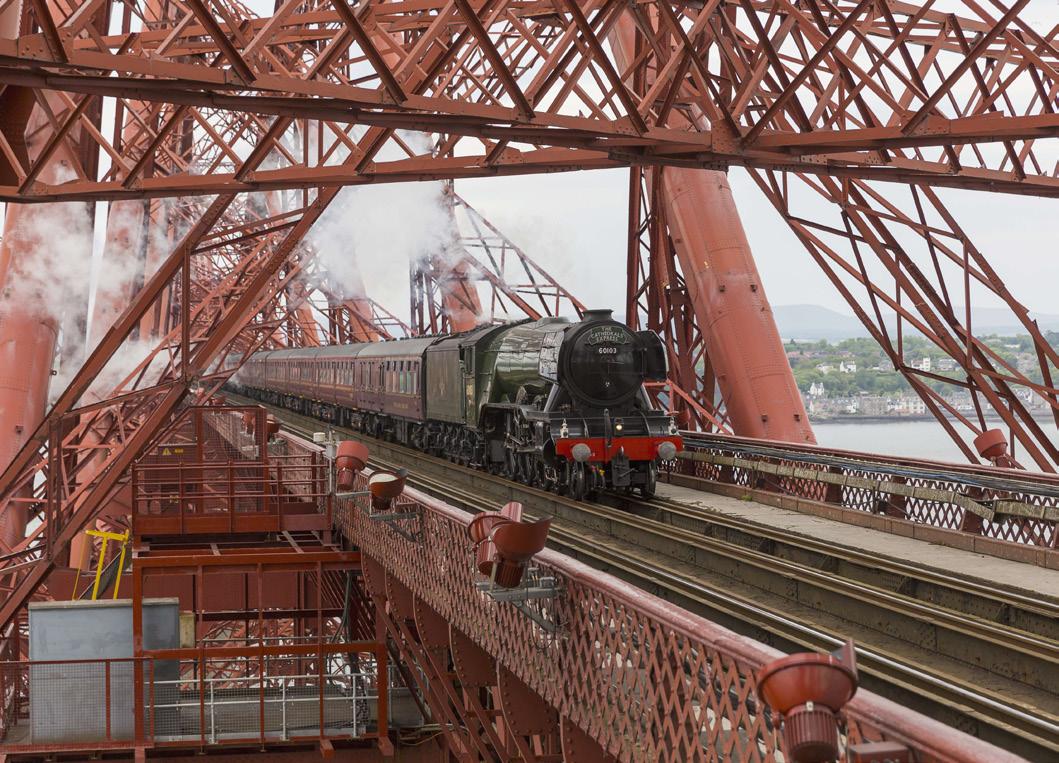
3 minute read
Iconic railways poster arrives in Edinburgh
National Museums Scotland has acquired the original artwork for LNER’s 1932 advertising campaign ‘Take me by the Flying Scotsman’ by A R Thomson.
It was created for a railway poster titled LNER 'Take me by the Flying Scotsman Leaves Kings Cross at 10am weekdays. With apologies to the Southern Railway.’ The painting shows the enormous, gleaming wheels and engine of the Flying Scotsman with a child standing on the adjacent platform looking up in awe at the driver.
Advertisement

Photo Science Musuem CC BY-NC-SA 4.0
It was intended as a pastiche of a Southern Railway poster "I'm Taking an Early Holiday cos I know Summer Comes Soonest in the South" which showed a child talking to an engine driver. LNER wanted to project a very different image, one of speed and modernity, and Thomson was mocking Southern Railway’s homely style.
The age of railway art as a serious field of commercial design took off in the 1920s and reached its pinnacle in the 1930s. Before the First World War railway posters were text-heavy, cramming in as much information about a service and its destination as possible.
In 1923 the government grouped into four regions those rail companies which had survived the First World War. Although divided geographically they were still in competition with one another due to overlapping territories and routes. Railway poster art, as we recognise it today, was born along with the creation of these new companies.

Photo Science Musuem CC BY-NC-SA 4.0
Each was keen to promote their own distinct style and region, and LNER took the progressive step of appointing an advertising manager and introducing a poster campaign. Soon the company had a reputation for producing exciting and innovative work, setting a standard in poster design that none of its rivals could match. LNER kept five artists on exclusive contract from 1926 until 1932 and commissioned a new typeface.
When the contracts expired in 1932, the company approached A R Thomson to create new works. The focus on the impression of speed and the scale of the shiny locomotive, conveyed in the distinctive Art Deco style, is in marked contrast to the more traditional railway poster art which showed bucolic images of a destination rather than the experience of train travel itself.

Flying Scotsman
David Ingham CC BY-SA 2.0
Possibly for this reason, and despite its artistic merits, when the poster was displayed on station platforms it was not as popular with the public as the Southern Railway design. However the railway advertising managers recognised the value of being provocative.
In 1929 the Public Relations and Advertising Officer for Southern Railways wrote, ‘the most valuable asset of a well-designed poster is its shock value…its kick, strength, visibility, immediate readability.’ In this regard Take me by the Flying Scotsman is a classic of its time.
The Flying Scotsman locomotive was built in Doncaster for LNER in 1923. It was designed by Sir Nigel Gresley as part of the A1 class – the most powerful steam locomotives used by the railway. By 1924, when it was selected to appear at the British Empire Exhibition in London, the locomotive had been named after the express passenger rail service between London and Edinburgh which ran daily at 10am from 1862.

Flying Scotsman crossing the Forth Bridge
Kenny Lam / VisitScotland
The service became a by-word for the luxury of rail travel between the wars. Although the locomotives have been replaced several times since the original A1, the service has continued to be named the Flying Scotsman.
Take me by the Flying Scotsman will go on display in the National Museum of Scotland in Edinburgh.
“This striking artwork evokes the obsession with speed, industry and modernity which influenced graphic design in the twenties and thirties. An iconic image which broke new ground when it was created, it’s a beautiful reminder of a golden age of rail travel,” said Meredith Greiling, Senior Curator of Transport at National Museums Scotland.
“This is an important addition to our internationally significant railway collection and we are grateful to Art Fund and the NMS Charitable Trust for their support.”

